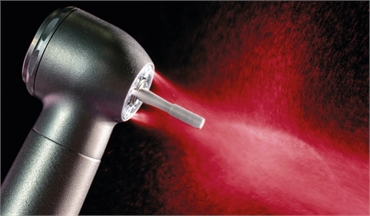How clean is your handpiece

Contamination
The handpiece is a vital piece of equipment in any dental surgery. But, it is one that is heavily contaminated internally with saliva, blood products and tissue. It has been demonstrated that contamination occurs when the treatment procedure is interrupted resulting in re-suction. Incorrectly or poorly maintained Dental Unit Waterlines can also introduce contamination. This is in addition to the contamination which covers the external surfaces following treatment.
Despite heavy usage and the potential for internal contamination, the handpiece is a tool with inherent design floors. The complex internal lumen and intricate water and air channels make removing this debris incredibly difficult and pose dental professionals with an issue – How do you clean and disinfect a handpiece?
Falling short of Standards
The decontamination and maintenance of a handpiece is done in three steps – cleaning, disinfection, then lubrication and sterilization.
Due to the complexity of the internal lumens of a handpiece this area is often glossed over and “cleaning” refers to manual brushing/ wiping of the outer surfaces followed by a visual inspection.
Often lubrication/cleaning oils are applied to handpieces due to the claims of cleaning activity. The newly published HTM01-01 points out that "The addition of oil-based compounds to the cleaning process is wrong in principle, as they cause contamination over the entire cleaned surface. Only the water-soluble type should be used. Mineral oils have poor biocompatibility and can inhibit the penetration of steam or sterilant gases on terminally sterilized product." This is for acute care but the point remains - you can't sterilise a dirty handpiece and cleaning is not achieved by lubrication.
The new legislation for acute care goes further to state that:
"Lubrication should only be applied to those areas where it is required during the inspection/packing process after thorough cleaning of the instrument"
HTM01-01 Part D
Evidence suggests that washer disinfectors with handpiece irrigation systems can significantly reduce the contamination when used. As most practices in the UK are yet to embrace mechanical cleaning fully, this must be compared with the current standard – Manual Cleaning.
Manual Cleaning
Manual cleaning is not able to remove the internal debris present in a handpiece. The contamination left behind is “baked” onto the surface during sterilization rendering the reprocessed handpiece potentially contaminated with blood product.
A dirty handpiece will not be decontaminated by sterilisation, only the application of the full decontamination cycle can render it safe for re use. It is recognised in the HTM01-05 that non-vac autoclaves will have no effect on the sterility of a handpieces and that washer disinfectors can have a positive impact if compatible.
"Cleaning and drying of reusable load items before packaging and sterilization is essential, since the efficacy of the process will be reduced if soiling protects microorganisms from exposure to the sterilant. All items should therefore be scrupulously clean."
HTM01-01 Part D
Practices may well be falling short of the standards expected by not fully cleaning this critical piece of equipment,
The Solution
So what is the answer? Disposable handpieces ? – well that’s not going to happen, but for practices without washer disinfectors how is this problem being addressed?
In order to ensure these expensive tools are maintained and safe to use an internal handpiece cleaning system must be applied in addition to manual cleaning and sterilisation. The risk of “baking on” proteins and cross contamination is removed when the handpiece can be fully decontaminated with a clinically assured and validated cleaning system and then sterilized effectively.
From the manufacturers of Alpron, the WL system for handpiece cleaning and disinfection use the same clinical expertise to ensure the internal surfaces of handpieces can be decontaminated as effectively as your DUWL’s. The WL system removes blood product and has excellent microbial efficacy.
The System
The system is delivered in pressurized spray cans. The solution is forced through all internal channels flooding the contaminated areas and removing debris and blood product without bonding or damage.
CLEAN – WL-Clean removes blood, saliva and debris without bonding or damage
DRY – WL-dry removes all chemical residues and prepares the handpiece disinfection.
DISINFECT – WL-cid chemically disinfects the internal lumens and surfaces making it safe for sterilisation
DRY – WL-dry removes all chemical residues and prepares the handpiece for lubrication and onward sterilisation.
Make your handpiece SAFE for use on your patients, PROTECT them against the risk of cross infection and TRUST the WL System as your handpiece decontamination assurance.
Don’t just take our word for it – NSK, Sirona and many others approve the WL System for its excellent material compatibility and cleaning efficacy.
https://www.qwsonline.co.uk/13-handpiece-water-lines
http://blog.qwsonline.co.uk

